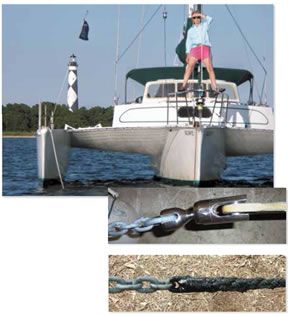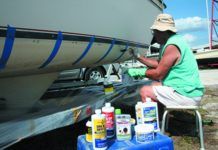Photos courtesy of Mark Johnson

As a boatbuilder/multihull cruiser for 45 years and the author of the recently released Anchoring and Mooring the Cruising Multihull ebook, I take issue with your response to Tom Welch (PS Advisor, July 2014), that he should not use a swivel connection in the anchor rode of his 41-foot catamaran.
With multihulls of this size or under, particularly trimarans or catamarans like Welchs Maine Cat, ground tackle requirements and anchoring techniques vary from monohulls a lot.
With weight-sensitive boats, one has to achieve very reliable holding with the lightest ground tackle as is practical. When these smaller multihulls are driven to windward in a seaway, they can suffer terribly from carrying too much weight on the bow. Depending on wing clearance, results of overloading can vary from just an obnoxious ride with incredible racket below, to structural damage from square waves hitting the boats underwings.
For boats the size of my 34-foot trimaran up to 40 feet or so, I recommend rope-chain rodes using custom-made, quarter-inch HT/G4 chain with an oversized link in the end, so that it will accept strength-comparable hardware. This 130 feet or so of chain would be carefully spliced to 250 feet of rope rode in a way that keeps sand and debris out of the splices interface.
If you use a boat-length bridle, the boat will point dead into the wind at anchor, making the load on the ground tackle just a fraction of the load on a similar-sized monohull when it saws back and forth. Also, a 35- to 40-foot bridle acts as a snubber too, and you no longer need the superior cushioning catenary effect of heavier chain. You do however need to use longer scope (at least 7:1) when you can, to make up for the lighter chain. It is all a trade off, but in my opinion, its the safest one.
On medium to small multihulls, I don’t recommend sizing ones primary anchors and tackle for use in hurricanes, although I have been in over a dozen of them, many at anchor, and I can assure you that the weak link in this situation is the anchors holding power rather than the rode. Carrying a primary anchor oversized by 10 or 20 pounds, as Welch planned to do, would pay dividends without as much of the excess pitching side effect that one gets with an extra 150 pounds or so of larger chain or all chain, when your cruising destination doesn’t really require it.
With medium to small multihulls, to increase the overall safety and reliability of your anchoring system, you cannot add weight at the bow. Much of the conventional wisdom gleaned from monohulls over the years, therefore, does not apply to weight-sensitive multihulls.
With monohulls, I can see both sides of the swivel argument, but with this size multihull, the debate becomes more complicated. If you use all chain, then the windlass gypsy will generally take twist out on the up or down trip with the chain. If you accumulate twist when laying to the hook, once the anchor is off the bottom, these twists will likely come out if you let the anchor dangle and spin.
On trimarans, where the distance from anchor connection to windlass might be just 5 feet, this is even more important, especially if you use a chain tensioner, as we do. These require that there be no twist in the chain, so that the pre-adjusted tensioner pulls the anchor into the roller tight and rattle free. For this reason, a swivel anchor connection can be very useful. It allows one to manually take the twist out of the last few feet of chain when needed. For hand-over-hand retrieval on small boats, however, a swivel is not needed at all.
Like PS, I generally prefer to avoid using stainless hardware underwater, especially with swivels, with one exception-the German-made WASI Powerball. All surfaces on this design, including the bearing surfaces, can be inspected for crevice corrosion. We have one of these jewels, and being smoother with more bearing surface, it works better than anything else, although none of them swivel under extreme loads. After 10 years of regular use and perhaps 1,000 days/nights spent on the bottom, ours is still pristine.
Our vastly oversized Powerball mates only to the -inch G-4 chain because of the chains oversized end link. (Oversized end-link Acco chains are easy to order.)
This swivel is so expensive (starting at $228 through importer SWI-TEC America) that I would not call it practical, but even in common, high-quality galvanized hardware, the point in achieving safety is to get the best brands, make them two times the safe working load of the rest of the tackle, connect them correctly, inspect them on occasion, and replace any bits and pieces at the first sign of wear. The weak link in such a carefully built rope/chain rode would probably be dragging anchor or the rope portion of the rode being cut by something sharp.
Mark Johnson
Delphys, 34-foot Searunner
North Carolina
Thank you for raising these excellent points regarding multihulls and the special requirements regarding anchor tackle. Although the published data for the WASI Powerball swivel are encouraging, we are still reluctant to introduce stainless-steel into the anchoring equation, due to frequent inconsistencies in the materials and manufacturing processes. We prefer properly seized D-shackles or pin shackles for chain-to-anchor connections.
After reading your A Stern Look at Sterns article in the August 2014 issue, I was tempted to submit a lengthy essay/diatribe on the subject. Brevity being the essence of wit, however, I offer succinct quotes from sailor/author John Vigor: Excessive beam carried well aft is a prime cause of bad hull balance, and Narrow deep hulls are tender but comfortable at sea. Beamy, shallow hulls are stable and fast but not as seaworthy.
Richard Philip Blommaert
Adagio
Pisces Marine
Id like to suggest a long-term review of double-braid dock lines. They all seem to hold a boat just fine when new, but before long, some go stiff and unmanageable, while others stay soft and supple. I can see this just walking around my marina and caressing lines here and there.
I recently bought new lines, and within six months, they got so stiff they were nearly impossible to manage. Cleaning and using fabric softener only gave brief relief. I don’t want to make that mistake again, but I don’t know what lines will stand the test of time.
John Rizzi
Via email
Our test of old docklines (see Practical Sailor December 2007) shows that strength also suffers over time. A forthcoming report will look at docklines in more detail.
To preserve suppleness, we recommend giving ropes a freshwater rinse after every sail, if possible, or at least whenever you make a trip to the dock.
If a rinse isn’t enough, its time to wash. Check out the July 2011 issue online for washing tips. Once your lines are clean, we recommend using a cordage treatment to improve handling, reduce wear, and reduce water absorption (see PS December 2011 online). Skip the fabric softener and instead choose either Nikwax Rope Proof (www.nikwax.com) or Grangers 2-N-1 (www.grangers.co.uk). The fastidious owner who wants the ultimate in clean, easy-handling docklines should look for factory dry-treated lines that absorb less water, making for more comfortable docking in cold weather.
I was surprised that you compared three offset-hinged shackles with one center-hinged shackle (See PS July 2014 online).
The former are designed so that they will not release the load immediately, whereas the latter will release the load right away (as usually is needed for releasing a spinnaker from its sheet or guy).
The Tylaska shackle is clearly designed for handling heavy loads, and the latch and pin system has clear advantages, but I have used center-hinged Nicro shackles (without the extra weight of a swivel) with a plunger-pin very successfully on medium-sized racing boats.
Tim Hunt
Marblehead, Mass.
Raymarine has recently announced that there is a bug in its LightHouse II v10.40 software, which could result in a boats GPS position being incorrectly displayed on a chart, if the boat position in the charting app is set to partial or full offset. The potential risks of your GPS location being incorrect are great, so if your Raymarine electronics use the LightHouse II v10.40 software, be sure to install the most recent software update (v10.41), which resolves the issue. You can download the update from Raymarines website (www.raymarine.com); youll find it under the Service & Support tab, click on Software Updates.










































